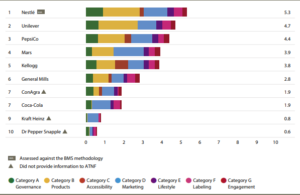Annals of marketing: Uber Eats’ contribution to U.S. diets
Oh great. Just what we need. You can’t make this stuff up.

Thanks to Elinor Blake for sending.

Oh great. Just what we need. You can’t make this stuff up.

Thanks to Elinor Blake for sending.
I was in Beijing last week, reading the English-language, government-issued China Daily in my hotel, and ran across this article about China’s “growing appetite for cheese,”
Cheese has never been part of traditional Chinese cuisines, and the Chinese still do not eat much.
Currently, annual per capita consumption of cheese in China is only 0.1 kilogram, far below 2.4 kg in Japan, 2.8 kg in South Korea, 15 kg in the United States and 18.6 kg in Europe where France, Germany and the Netherlands take the top three spots, according to the China Dairy Industry Association.
But there is a big push to encourage dairy consumption. Chinese dietary guidelines advise adults to consume 300 grams of dairy a day.
The annual per capita consumption of dairy products in China has reached 36 kg now, much higher than the 6 kg recorded two decades ago, but the volume is still less than half that of Asia and less than a third of the world average.
This all seems odd to me. Asian populations tend to be lactose intolerant, making dairy products difficult to digest. But dairy foods are believed to promote faster growth and taller heights in children, which the government deems desirable. Many people can handle dairy foods, especially yogurt and other fermented varieties.
I went to a large supermarket in an area where many foreign embassies are located and was impressed by the size of the dairy aisle.

But on an Untour Food Tour to Beijing’s lower income alleys (hutongs), I was taken to a tiny store devoted exclusively to dairy products.

Most of the products were milk or yogurt. The cheese in both places was mostly slices, Kraft and the like.
But in an indoor farmers’ market, I visited Le Fromager de Pekin stall and did some tasting. At the moment, French cheese makers (or American, for that matter) have nothing to fear from Chinese competition. I will be interested to see how cheesemaking progresses.

In the meantime, I’m not the only one fascinated by the very thought of cheese in China. DairyReporter.com notes:
Three decades after most consumers had tried their first cheese slice or milk shake, fortunes have changed dramatically for dairy in China.The country is now the world’s biggest importer of dairy products, with a younger, more mobile generation ravenous for cheeses from overseas. With a market value of US$12bn today, cheese sales are expected to grow by US$4bn over the next year, according to Mintel. In just two years the number of Chinese cheese-eaters has grown from 15% to 17% in 2017, with the market researcher anticipating further rises of 13% annually until 2021.
As for dairy use, the unanticipated consequences are already emerging, not least the environmental impact of the transition from sheep to dairy cows in New Zealand.
A massive rise in the country’s dairy herd over the last 20 years has had a devastating impact on the country’s freshwater quality, a key area being targeted by the government for improvement….groundwater failed standards at 59% of wells owing to the presence of E coli, and at 13% of the wells owing to nitrates. Some 57% of monitored lakes registered poor water quality, and 76% of native freshwater fish are at risk of or threatened with extinction…the main culprits for worsening freshwater quality were the intensive use of fertilisers, irrigation and cows.
And much of this is driven by China’s purchases of New Zealand’s dairy production.
Kiwi companies sold $4b worth of dairy products in China. Milk powder, butter and cheese mainly. The success of dairy companies Fonterra and A2 is largely underpinned by exports to China. Fonterra [a New Zealand company] accounts for 36 per cent of all dairy imports into China…11 per cent of China’s total dairy consumption was produced by Fonterra, and 26 per cent of Fonterra’s output was shipped to China.
It’s hard to believe that any of this is good for the health of people or the envirornment.
Here is a summary of another funded study with results the funder must love.
Joint associations between weekday and weekend physical activity or sedentary time and childhood obesity. Li N, and 19 additional authors for the ISCOLE Research Group. International Journal of Obesity (2019) 43:691–700.
Conclusions: Lower levels of MVPA [moderate to vigorous physical activity] or higher levels of sedentary time on either weekdays or weekend were associated with increased odds of obesity in 9–11 year old children in 12 countries.
Funding: The International Study of Childhood Obesity, Lifestyle and the Environment (ISCOLE) was funded by The Coca-Cola Company… With the exception of requiring that the study be global in nature, the funder had no role in the design and conduct of the study; collection, management, analysis and interpretation of the data; and preparation, review or approval of the manuscript.
Comment: This is another paper from the ISCOLE study funded by Coca-Cola, that seems to be aimed at casting doubt on the idea that sugary beverages might promote weight gain. Instead, these results suggest that physical activity is a more important factor. Of course physical activity is important for health, but doesn’t expend nearly as many calories as is usually needed to compensate for soft drink intake.
I learned about this study from a Weighty Matters blog post by Dr. Yoni Freedhoff, who runs a weight management center in Ottawa. In his view, the ISCOLE study ignores evidence that childhood obesity is a determinant of physical activity, “not the other way around.”
He also questions the “no influence” statement in the funding disclosure, on the basis of
emails between ISCOLE investigators and Coca-Cola that not surprisingly suggests that these relationships have the very real potential to influence the framing of results even if funders [are] not involved in study design.
As I discuss in Unsavory Truth, the influence of food-industry funders appears to occur at an unconscious level; investigators do not recognize the influence and typically deny it.
As I also discuss in that book, Coca-Cola generously funded the ISCOLE study some years ago. It has since changed its policy on research funding.
The National Academies of Science, Engineering, and Medicine has a new report out on Science Breakthroughs to Advance Food and Agricultural Research by 2030.
In the next decade, the major goals for food and agricultural research include (1) improving the efficiency of food and agricultural systems, (2) increasing the sustainability of agriculture, and (3) increasing the resiliency of agricultural systems to adapt to rapid changes and extreme conditions.
To that end, the committee that wrote this report examined “breakthrough opportunities that could dramatically increase the capabilities of food and agricultural science.”
The breakthroughs?
I’m worried about how all this will help make agricultural production more sustainable. For that, we need smaller scale, fewer chemical inputs, crop rotations, and other such methods. I wish NASEM would do a serious study on agricultural sustainability.
Update, May 26: Benjamin Chaulet has translated this into French and posted it on his blog, nutrition-newage.com. Here is a pdf.
I’m trying to keep up with what’s happening with Cannabis edibles and drinkables, still with borderline legality in most places, but gradually working their way to supermarkets near you.
Here’s what’s come up lately.
And then there are the health claims. As early as 2017, the FDA sent out warning letters to makers of CBD products; they were marketing their products as drugs not supplements or foods.
For example, the FDA sent a letter to That’s Natural, complaining that the company published testimonials saying things like this:
The FDA also sent a letter to Green Roads of Florida objecting to claims like these:
Food, medicine, supplement, or snake oil? We shall see.
I am occasionally asked to comment on new studies that appear. Practice Update: Diabetes asked for a comment on this study:
VS Malik, et al. Long-Term Consumption of Sugar Sweetened and Artificially Sweetened Beverages and Risk of Mortality in US Adults. Circulation. 2019;139:00–00. DOI: 10.1161/CIRCULATIONAHA.118.037401
The study concluded: “Consumption of SSBs [sugar-sweetened beverages] was positively associated with mortality primarily through CVD [cardiovascular disease] mortality and showed a graded association with dose. The positive association between high intake levels of ASBs [artificially sweetened beverages] and total and CVD mortality observed among women requires further confirmation.”
This study is based on analyses of data from two remarkably large and long-standing investigations of diet and disease risk. The investigators looked for correlations between mortality and consumption of sugar-sweetened beverages (SSB) and found them. More than two SSB servings a day was associated with higher mortality, particularly from cardiovascular disease, and, to a lesser extent, cancer.
Thus, this study adds to the increasing body of evidence associating SSBs with poor health. SSBs provide calories, but nothing of nutritional value. Other studies correlate SSBs with obesity, type 2 diabetes, and heart disease. A further correlation with increased mortality is not surprising, but it is good to have it confirmed.
These results associate high intake of SSBs with disease risk, but cannot prove that SSBs causedisease. Epidemiological studies like these, based on self-reported dietary data, require careful interpretation. In part, this is because intake of SSBs tracks closely with other lifestyle characteristics. Heavy SSB users tend to be more sedentary, more likely to smoke, to consume more meat and calories, but to eat fewer vegetables than light users—overall, to have less healthy dietary habits in general. Still, reducing or eliminating SSB intake is harmless and could well improve health.
This is one of an ongoing series of examples of how industry funding skews, or to be more precise, is strongly associated with skewing, of research and opinion about matters of diet and health.
This example is an analysis of the scientific rigor of dietary approaches to controlling type 2 diabetes through diet. The authors looked at the evidence for efficacy of the DASH, Mediterranean, Plant-Based, and Low-Carb diets.
Improving the Scientific Rigor of Nutritional Recommendations for Adults with Diabetes: A Comprehensive Review of the American Diabetes Association Guidelines Recommended Eating Patterns. Hallberg S, Dockter NE, Kushner J, Athinarayanan S. Preprints 2019. Online March 5. doi: 10.20944/preprints201812.0187.v2
Conclusion: “Our review of the current Standards and Recommendations finds significant shortcomings regarding scientific review methodologies, which are likely to translate to suboptimal clinical care decisions for patients with T2D.” The study dismisses most studies of the DASH, Mediterranean, and Plant-based diets as poorly done or otherwise inappropriate for their review. For the DASH diet, it says more research is needed. It calls for more research on whether the benefits of Mediterranean diets are due to low carb or healthy fats, and suggests that the benefits of plant-based diets may be due to weight loss. The best evidence supports the Low-Carb diet: “Evidence from 30 trials and 10 follow-up studies demonstrates that a low-carbohydrate diet is an effective dietary approach for addressing dyslipidemia.”
Conflict of Interest Statement: SJH is an employee and shareholder of Virta Health, a for-profit company that provides remote diabetes care using a low-carbohydrate nutrition intervention, and serves as an advisor for Atkins Corp. NED is a paid consultant for Virta Health. JAK serves as medical director of McNair Interests, a private equity group with investments in type 1 diabetes and other chronic illnesses, and is also an advisor for Sanofi and Lexicon.
Comment: All authors are employed by or consult for a company that uses low-carb dietary approaches in its for-profit business. As I explain in Unsavory Truth, the influence of industry funding is often unconscious, unintentional, and unrecognized. Nevertheless, the opinions of the authors can be predicted from their financial connections to Virta Health.
The George Institute in Australia (see clarification below) publishes an annual index holding the ten largest U.S. food and beverage corporations accountable for how they addrss nutrition challenges.
The 2018 Index ranks corporations on their governance, products, accessability, marketing, lifestyle, labeling, and engagement. Here’s what it looks like.

Here’s how this is explained:
Seven out of ten companies claim to focus on improving health and nutrition (all except Coca-Cola, Dr Pepper Snapple and Kraft Heinz), as expressed in their mission statements or corporate growth strategies, the objectives they defined related to health and wellness are mostly limited to product development, product reformulation and responsible marketing. Only two companies (Nestlé and Unilever) have defined a more comprehensive set of objectives within their nutrition strategy.
To remind you: food corporations are not social service or public health agencies. They have stockholders to please as their first priority. The conflicts of interest with public health approaches are obvious. That’s why none of them does particularly well on this Index.
Clarification from a reader
I believe you are referring to the US Spotlight Index, a product of the Access to Nutrition Foundation, an independent nonprofit in the Netherlands. (https://www.accesstonutrition.org). The George Institute provided research support for the US Spotlight index. RWJF [Robert Wood Johnson Foundation] was a major funder. The Foundation has also published an India Spotlight Index (2016) and a Global Index (latest in 2018). Shiriki Kumanyika chairs the Expert Group.